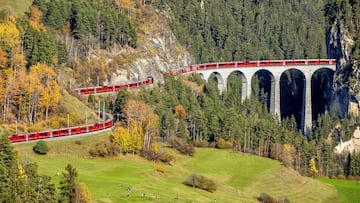The record breaking 2-kilometer-long Swiss train
The Swiss railway industry managed to run the longest train in the world over difficult terrain. It was made up of 100 wagons and measured over a mile long.

The Swiss railway industry has set itself a goal to celebrate the 175th anniversary of the country’s first railway: to run the longest passenger train in the world. And indeed, it achieved its purpose.
Switzerland has managed to enter the Guinness Book of Records thanks to its amazing union of 100 wagons, weighing 2,990 tons, that measured almost 1.2 miles long (1,906 meters). The milestone has already been certified.

As detailed by CNN, the train was made up of 25 ‘Capricorn’ electric trains. The railway invested almost an hour to cover a route of approximately 15.6 miles (25 km) on the Albula line, which in 2008 was declared a World Heritage Site by UNESCO.
The record attempt was organized by the Rhaetische Bahn (also known as the Rhaetian Railway or RhB) and supported by the Swiss train builder Stadler.
A difficult route
Beyond the beauty of the route chosen to achieve the record, which runs through the Swiss Alps, it should be noted that it involved facing a series of notable technical difficulties.
One of the main ones was the width of the track. Unlike most Swiss and European railways, which make use of the ‘standard gauge’ between rails of 1.435 meters, the RhB rails were only one meter apart.
Related stories
The other big problem was the complicated physical geography. The line, which starts in Preda (5,866 feet above sea level) and reaches Alvaneu (3,278 feet above sea level), is made up of a succession of spirals, viaducts and tunnels.
Specifically, the incomparable railway had to overcome 22 tunnels and 48 bridges, which, in turn, were linked by very sharp curves and, how could it be otherwise, steep slopes.

